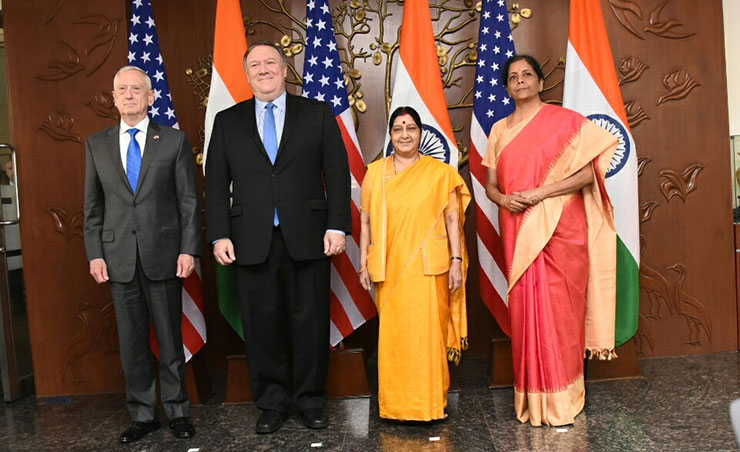
THE INAUGURAL meeting between Foreign and Defence Ministers of India and the United States under the rubric of 2+2 Dialogue on September 6 and before that, the decision by the United States to upgrade India from Strategic Trade Authorization (STA)-2 to STA-1 category on July 30 have come as a huge shot in the arm for ties between the two countries.
The two-time postponement of the 2+2 Dialogue had emboldened the critics of stronger India-US partnership to charge that the relationship was in serious trouble as US President Donald Trump was miffed with Prime Minister Narendra Modi, and the US was not according the same priority to relations with India as it was doing earlier.
This bogey was partially busted with the upgradation of India to STA-1 status and was laid to rest completely with the highly successful deliberations during the 2+2 Dialogue.
UPGRADE OF INDIA TO STA-1 CATEGORY
In STA-2, only a limited number of dual-use technologies could be imported by India. By its inclusion in STA-1, India can import more than 90 per cent dual use technologies whose export is severely restricted by US and is permitted only to its NATO allies and some other trusted partners with robust export control systems.
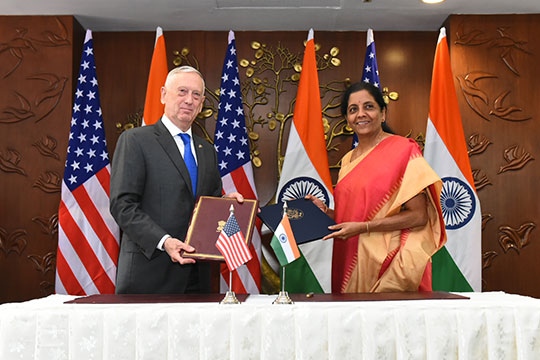
Upgradation of India to STA-1 status where it is in company with Japan and Republic of Korea (ROK) from Asia, is testimony to the increasing confidence and trust levels between India and the US. The US has taken this decision, notwithstanding the fact that India is not a member of Nuclear Suppliers Group (NSG), to send out a clear message to China that its unreasonable objection to India’s accession to NSG will not succeed in creating obstacles in smooth and rapid development of ties between the two countries. STA-1 status has not been provided even to Israel as it has not acceded to all the four export control regimes. Even some members of NATO like Albania are not beneficiaries of STA-1 privileges.
FROM ASIA-PACIFIC TO INDO-PACIFIC
Change of terminology from ‘’Asia-Pacific’’ to ‘’Indo-Pacific’’, which was brought about principally by usage of the latter formulation in place of the former by President Trump during his visit to Asia in November 2017, is designed to recognise the growing importance of India in world affairs and the fact that India will play a significant role in shaping any economic or security architecture that evolves in the region. Change of the name of US Pacific Command to US Indo-Pacific Command underlines the continuum of Indian and Pacific Oceans and recognition that security of both these water bodies is closely interlinked.
COMCASA
One of the most significant outcomes of the recently-held high-level Dialogue between India and the US was the signing of the Communications, Compatibility and Security Agreement (COMCASA). This is a modified version of the Communications, Information and Security Memorandum of Agreement (CISMOA) to suit Indian requirements and demands. Discussions on India becoming a member of this agreement have been in process over the last two decades.
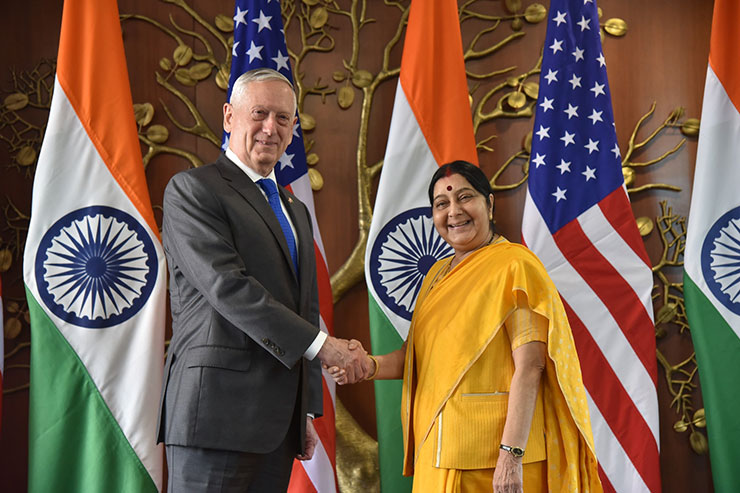
Initially there were persistent concerns in India that this would allow US Navy access to India’s own secure communication network and also that the information shared with the US will be accessible to Pakistan. Indian officials have brushed aside these fears as specific measures against this have been incorporated in the agreement.
the US
India’s accession to the Agreement will facilitate greater interoperability between forces and military hardware of the two countries, and also possibly with other countries that operate on US-origin platforms. COMCASA will enable Indian military to get a better picture of the Indian Ocean Region (IOR) which is seeing increasing Chinese movements. Indian armed forces will get to fully exploit the capability of the military platforms procured from the US. For instance, the P-8I reconnaissance aircraft of the Indian Navy which has emerged as a major force multiplier is currently operating at limited capacity. The Agreement is meant to provide a legal framework to allow transfer of encrypted communication security equipment from the US to India, which is much safer and more secure than the system that India uses right now. Currently, Indian military reportedly uses a locally-sourced platform to communicate between various weapons systems, which also includes the platforms that India has acquired from the US.
DEFENCE RELATIONS
The Defence sector has emerged as arguably the most significant component of the strategic relationship between India and the US. The Joint Statement issued at the end of the 2+2 Dialogue speaks about greater focus on the Defence Technology and Trade Initiative (DTTI) for progressive development, designing and manufacture in India of equipment purchased from US. This will make the relationship more viable and sustainable by ensuring transfer of technology and generating more employment in India. When implemented, this will be a big impetus to the government’s ‘’Make in India’’ initiative.
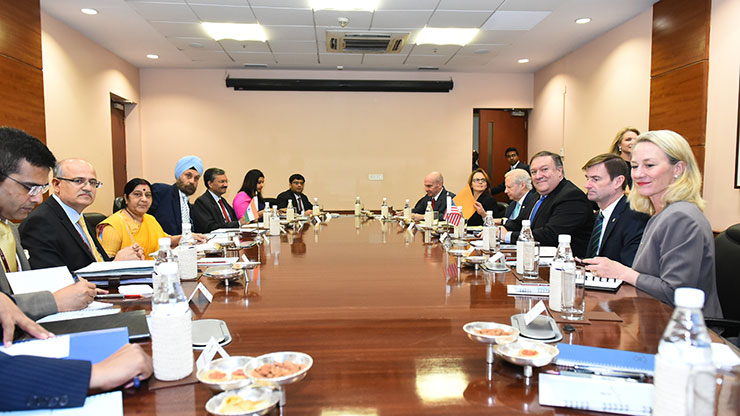
Tri-service exercises in 2019, announcement of which was made at the Dialogue, will add further muscle to the partnership.
A Memorandum of Intent (MoI) between US Defense Innovation Unit (DIU) and the Indian Defence Innovation Organization – Innovation for Defence Excellence (DIO-iDEX) was signed. This will elevate defence partnership to the next higher level.
Hotlines between the Foreign and Defence Ministers of the two countries will help to expeditiously remove any bottle-necks in steering the relationship forward and take advantage of new opportunities that arise.
Promoting security, stability, peace and prosperity in Afghanistan was an important item on the plate. Pressure by the US on Pakistan to not permit territory controlled by it to be used by terrorists, to take strong action against terrorists operating from its territory, and demand expeditious trial and punishment of perpetrators of 26/11, Pathankot and Uri attacks, were significant takeaways from the Dialogue.
INDO-PACIFIC
Both sides agreed that they will work together to ensure a free, open and inclusive Indo- Pacific based on recognition of Association of Southeast Asian Nations (ASEAN) centrality and respect for sovereignty, territorial integrity, rule of law, good governance, free and fair trade, and freedom of navigation and overflight. This is a clear cut message that India, US and their partner countries will protect their interests in the region notwithstanding the increased assertiveness of China. They also agreed to cooperate with other partner countries to support transparent, responsible, and sustainable debt financing practices in infrastructure development. This is also a tangential reference to the unviable, unsustainable projects under the Belt-Road Initiative of China which have been implemented through predatory debt financing practices.
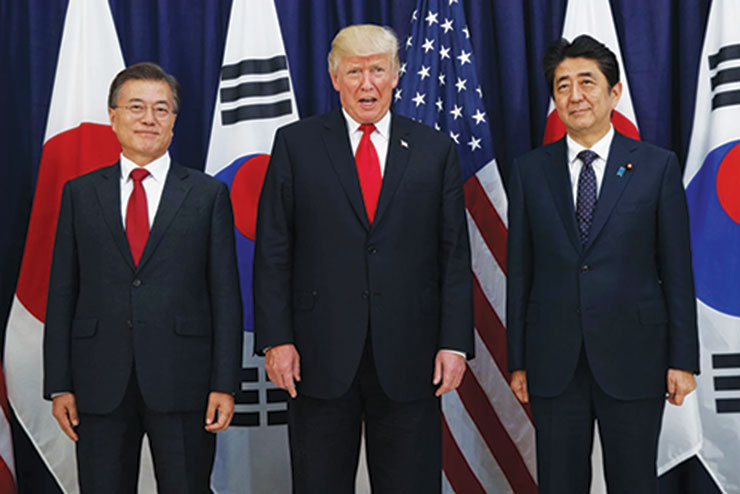
Reference in the Joint Statement has also been made to enhancing people-to-people contacts, expanding bilateral trade and also promoting cooperation between the Nuclear Power Corporation of India Limited (NPCIL) and the Westinghouse Electric Company to establish six nuclear power plants in India.
WAIVER FROM CAATSA AND IRANIAN SANCTIONS
Although this subject does not find mention in the Joint Statement, the issue of import of S-400 anti missile defence system from Russia and reducing oil imports from Iran and continuation of India’s engagement with the Chabahar project would definitely have been a subject of discourse among the four Ministers.
National Security Adviser Ajit Doval has travelled to Washington DC within 10 days of the 2+2 interaction to take the matter forward and find a mutually acceptable solution to the issues. It is expected that the obstacle in the way of the S-400 system will be satisfactorily resolved. When discussions on providing waivers from provisions of CAATSA (Countering America’s Adversaries through Sanctions Act) were being held in the US Congress, both Secretaries Mattis and Pompeo had strongly argued to provide a waiver for Indian acquisitions from Russia. They had vigorously contended that India should not be made an unintended victim of CAATSA.
On oil imports from Iran, India is likely to inform the US that keeping in view India’s energy security, increasing prices of energy in the international market, rising prices of petrol and diesel in the domestic market, falling value of Indian rupee, and the adverse impact that increased energy prices will have on overall inflation and economic stability in India, it will continue to import progressively decreasing but significant quantities of more competitively priced Iranian oil even after the deadline of November 4, 2018. On Chabahar, India is likely to get a waiver as India’s connect to Afghanistan and Central Asia is strategically important for US also to promote peace and security in the region. Signals to this effect had been provided during the recent visit of US Permanent Representative to the United Nations Nikki Haley to India.
TRADE AND INVESTMENT
Trump has repeatedly raked up the issue of India imposing high import duty on the Harley-Davidson motorcycles and threatened to increase import tariff on “thousands and thousands” of Indian motorcycles that are exported to the US. Discussions on this divisive issue and other related matters of India’s trade surplus with US would also have been held at the 2+2 deliberations. This would be in continuation of talks conducted by Commerce Minister Suresh Prabhu during his visit to the US in June, 2018 to reduce it’s trade deficit with India.
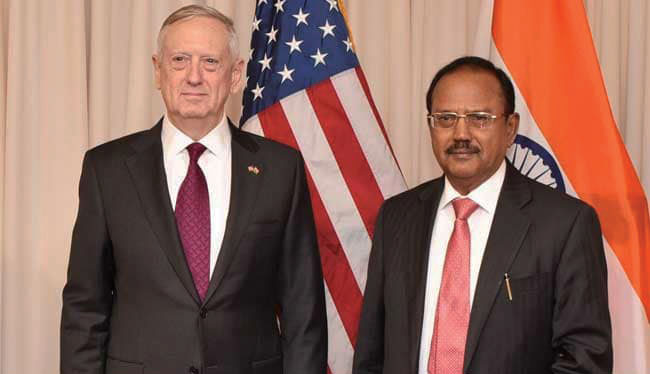
Although the trade surplus that India enjoys with US is quite minimal in comparison to the overall global trade deficit that latter suffers but Trump’s occasional, unwarranted outbursts demand that some visible corrective action be taken, it can be expected that detailed examination of all relevant issues would be conducted soon in a separate forum.
CONCLUSION
Discussions in the 2+2 Talks and by NSA Doval in Washington DC provided a welcome opportunity to the two sides to get a better understanding of each other’s interests and reduce the distance between their positions on a few contentious issues.
It can be expected that further discussions in this format and subsequent meetings between leaders of India and the US will provide a fillip to the multifaceted relations between the two countries.
– The author is former Indian Ambassador to Kazakhstan, Sweden and Latvia.








